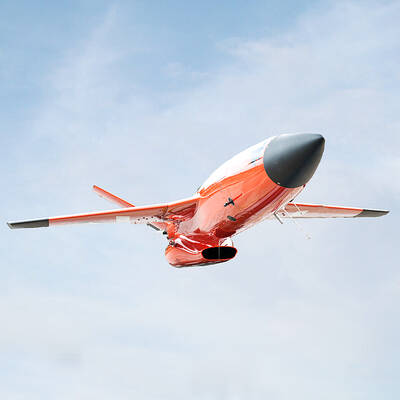President William Lai (賴清德) praised the progress made in Taiwan’s ongoing domestic shipbuilding project, while presiding over a keel-laying ceremony for a domestically built light frigate prototype in Kaohsiung yesterday.
Speaking at Jong Shyn Shipbuilding Co (中信造船), Lai said it took the company about a year to reach the second phase of constructing the 2,500-tonne light frigate prototype.
In November last year, then-president Tsai Ing-wen (蔡英文) presided over a commencement ceremony for the anti-air light frigate prototype, Lai said.

Photo: Daniel Ceng, EPA-EFE
Yesterday marked a major milestone in the nation’s indigenous ship and aircraft construction project, Lai said.
The project, initiated during Tsai’s administration, exemplifies Taiwan’s determination to defend itself while boosting the local defense industry’s development, he added.
The prototype is the first navy vessel classified as a “Tier 2,” or second class, combat ship, he said.
Once it enters service, the vessel would be equipped with domestically built anti-ship and anti-air missiles developed by the Chungshan Institute of Science and Technology, the military’s top research unit, and would be responsible for patrolling seas around the nation, he said.
Laying the keel is one of several celebrated events in the life of a ship, signifying the beginning of the vessel’s construction.
Other ceremonies include launching, commissioning and decommissioning.
The anti-air light frigate prototype is one of two being built by the Kaohsiung-based Jong Shyn.
The other one is an anti-submarine prototype. Both are scheduled to be delivered to the navy by October 2026.
The navy said the vessels would patrol the Taiwan Strait, respond to situations in the “gray zone,” conduct reconnaissance and surveillance missions, escort transport ships and supplies to remote islands, secure sea lines of communication, and support training and exercises.
“Gray zone” tactics are generally defined as coercive actions that are below the threshold of war.
They can refer to Chinese aircraft flying maneuvers near Taiwan or China’s use of fishing fleets to stake out waters.

CROSS-STRAIT COLLABORATION: The new KMT chairwoman expressed interest in meeting the Chinese president from the start, but she’ll have to pay to get in Beijing allegedly agreed to let Chinese Nationalist Party (KMT) Chairwoman Cheng Li-wun (鄭麗文) meet with Chinese President Xi Jinping (習近平) around the Lunar New Year holiday next year on three conditions, including that the KMT block Taiwan’s arms purchases, a source said yesterday. Cheng has expressed interest in meeting Xi since she won the KMT’s chairmanship election in October. A source, speaking on condition of anonymity, said a consensus on a meeting was allegedly reached after two KMT vice chairmen visited China’s Taiwan Affairs Office Director Song Tao (宋濤) in China last month. Beijing allegedly gave the KMT three conditions it had to

STAYING ALERT: China this week deployed its largest maritime show of force to date in the region, prompting concern in Taipei and Tokyo, which Beijing has brushed off Deterring conflict over Taiwan is a priority, the White House said in its National Security Strategy published yesterday, which also called on Japan and South Korea to increase their defense spending to help protect the first island chain. Taiwan is strategically positioned between Northeast and Southeast Asia, and provides direct access to the second island chain, with one-third of global shipping passing through the South China Sea, the report said. Given the implications for the US economy, along with Taiwan’s dominance in semiconductors, “deterring a conflict over Taiwan, ideally by preserving military overmatch, is a priority,” it said. However, the strategy also reiterated

‘BALANCE OF POWER’: Hegseth said that the US did not want to ‘strangle’ China, but to ensure that none of Washington’s allies would be vulnerable to military aggression Washington has no intention of changing the “status quo” in the Taiwan Strait, US Secretary of Defense Pete Hegseth said on Saturday, adding that one of the US military’s main priorities is to deter China “through strength, not through confrontation.” Speaking at the annual Reagan National Defense Forum in Simi Valley, California, Hegseth outlined the US Department of Defense’s priorities under US President Donald Trump. “First, defending the US homeland and our hemisphere. Second, deterring China through strength, not confrontation. Third, increased burden sharing for us, allies and partners. And fourth, supercharging the US defense industrial base,” he said. US-China relations under

The Chien Feng IV (勁蜂, Mighty Hornet) loitering munition is on track to enter flight tests next month in connection with potential adoption by Taiwanese and US armed forces, a government source said yesterday. The kamikaze drone, which boasts a range of 1,000km, debuted at the Taipei Aerospace and Defense Technology Exhibition in September, the official said on condition of anonymity. The Chungshan Institute of Science and Technology and US-based Kratos Defense jointly developed the platform by leveraging the engine and airframe of the latter’s MQM-178 Firejet target drone, they said. The uncrewed aerial vehicle is designed to utilize an artificial intelligence computer